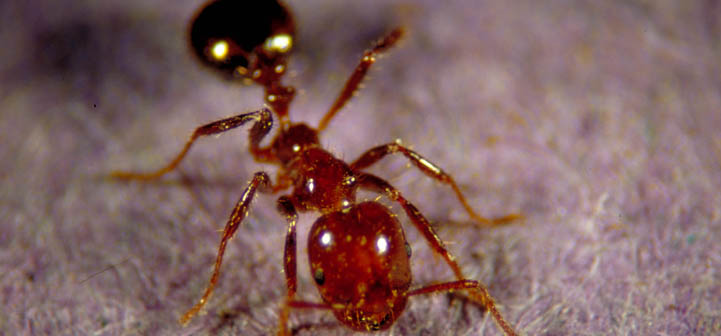Several kinds of fungi have been tested with varying degrees of success to help control fire ants:
- Hirsutella spp.
- Candida spp.
- Paecilomyces spp.
- Conidiobolus spp.
- Beauveria bassiana
- Metarhizium anisopliae
- Aspergillus flavus
- Myrmecomyces annellisae
There have been some promising results from research experiments. Some ant-attacking fungi cause a reduction in foraging activity, make fire ants more susceptible to stress, and kill larvae, workers, and exposed queens.
There have also been disappointing results of using ant-attacking fungi, some with logistical and environmental implications. For example, some fungi do not culture well in the lab or do not infect fire ants effectively. Other studies have revealed that fire ants have physical and chemical mechanisms to combat infection, growth, and/or the effects of various fungi. Fire ants can use their venom as a disinfectant.The alkaloids found in the venom can inhibit the growth of some species of fungi including Beauveria bassiana, Metarhizium anisopliae, and Paecilomyces fumosoroseus. Also, food filters in the “throats” of some fire ants may be small enough to filter out the spores.
After release, some fungi do not persist in the environment. When such fungi are applied to a fire ant mound, they kill the ants only in that mound. These treatments would be more expensive because consumers would have to treat each mound with the product, thus adding more time, labor, and product costs.
Another common concern of using biological control is that the agent may spread into the environment where it attacks non-target environments and organisms, most notably beneficial and desirable insect populations.
Not all fungi are species-, genera-, or even order-specific. They may attack non-target organisms, which could adversely affect ecosystems.
At present, many relatively cost effective, reliable, safe, environmentally friendly, research-based options already exist for fire ant management.
Insecticide products containing fungi must be registered by the Environmental Protection Agency (EPA).
Related Content
- Are there any home remedies that will kill fire ants?
- Natural enemies of fire ants
- Fire Ant Control: The Two-Step Method and Other Approaches
- Broadcast Baits for Imported Fire Ant Control
